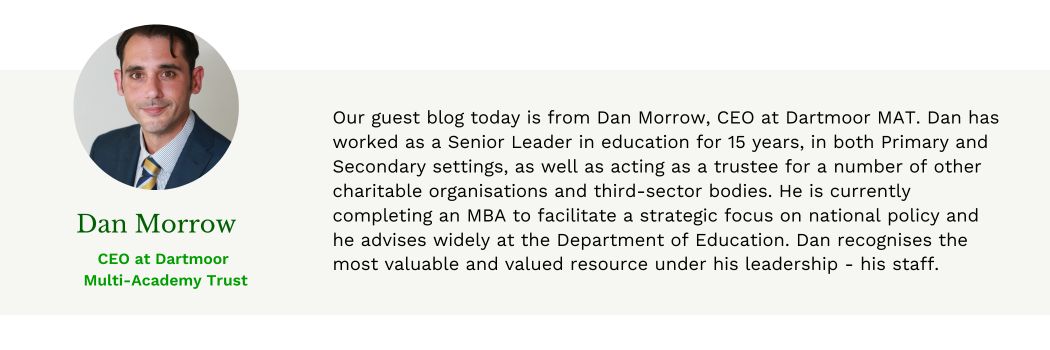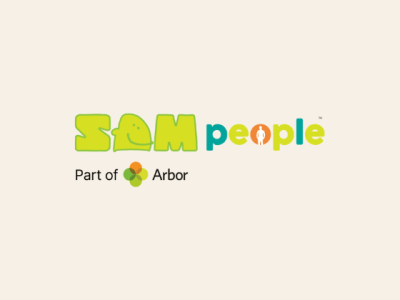
What does a good policy look like?
In thinking about policies, procedures and processes, success looks like meeting our charitable objectives as an academy trust. It goes without saying that everything we do should be furthering education and fulfilling our mission. However, we also subscribe very heavily to the work that the CST has done around civic trust and civic leadership. What that boils down to is that everyone within your organisation – the children, the families, our colleagues – get a sense of fulfilment, purpose, and a sense of joy. In challenging times around recruitment and retention, one of the core levers we have is to ensure that everyone feels deeply connected to their work. At Dartmoor, we start to do this by making sure that we ‘work with’, we don’t ‘do to’, in order to ensure both collegiality and alignment. We make an intentional effort to listen to all of the equally important voices in the organisation, which in turn makes our policies not only more well-known and understood, but more effective.
A lot of what we have in place is intentional by design – they don’t just happen by accident. If we’re thinking about which processes are important to design first, I think it’s vital that the processes around finance, people, estates, and, increasingly in the last few years, digital are clarified. But again, there should always be a sense of co-construction.
Finance, for example, in a MAT, is often a function that feels ‘done to’. People are told what they need to do to be compliant, and that’s that. I don’t like that in education, there’s schools or trusts and then there’s the support services – this makes for a separation. Trusts can be very legalistic in the way they set direction and goals, without making policies accessible for those actually using them. Our processes are codified in handbooks, formed through staff voices and working parties where we’re constantly checking in on whether they’re helpful, if they make sense, does it give staff what they need to reduce bureaucratic burden, do they feel they’re able to quickly, effectively and efficiently understand how to do x, y and z?
If you designed a new process for, let’s say, budget management, how do you actually practically roll that out? How do you communicate that?
Step one: create a draft playbook (this will tend to be done by the teams who are responsible)
Step two: market-test the draft with groups of colleagues, asking them to review and critique
Inclusion of our staff at this level means our policies are far more easily realised and enacted. More broadly, it really helps us to make sure we’re solving the right issues, because sometimes it’s quite easy to sit and put a process in place because we’ve looking at it from a compliance mindset.
Compliance vs culture
Compliance is really important because it’s foundational, but it can’t be seen as a separate strand from the culture and what we’re trying to promote in terms of that collegiality, that cooperation, and as I said, that sense of ‘doing with’ not ‘doing to’. The temptation when it comes to policies, processes and procedures is to always think about the 1%, that really sharp end of risk, and ignore the 99% aspect of how we need to be setting out our cultural norms, how it needs to be linked to our vision and values, and ultimately, how policies shouldn’t just be something that you go to when you need to enact them. It should be an absolute statement of both intent and a statement of our vision and values translated into important statements.
It’s important to acknowledge that this isn’t something we’ve perfected in our trust, yet. Even with the approaches I’ve mentioned so far, there can still be a bit of a disconnect between the policy as what’s seen as a legal document versus what we actually want it to be. And that’s because it has represented a step change. Especially for very experienced colleagues, their understanding of a policy is, here’s something I go to if I’m not happy or I’m in trouble or something’s coming up. There’s a change curve there that just takes a bit more embedding and reiteration.
Implementing policies in our schools
When it comes to people policies, the vast majority in our trust, are set at that central level. This is important for two reasons. From a compliance point of view, we have to remember we are one employer and therefore, actually, terms and conditions need to be equitable. From a cultural point of view, it’s important to ensure in our policies that we are able to promote what we want. And that’s why we’ve done such a lot of work on the flexible working policy, the menopause policy and others. It’s about being progressive so that these policies are about rights, not permissions. In terms of at school level, there’s always going to be headteacher discretion for the application of policy. It’s a roadmap, it’s not a straightjacket.
A good example would be our bereavement policy, for example. When I was younger my nan died. She was a really, really important part of my life. And actually that was something where I needed some flexibility because it affected me really quite deeply. You can’t capture that all in a policy, because you need to effectively standardise some aspects, but you can do that in your processes and procedures of being able to sit someone down and say, are you okay? What support do you need, how long do you need and what can we do to be there for you? It would be impossible to write down a policy that would encapsulate how everybody reacts in grief.
Making an effective policy
Ultimately, it should all come back to your vision and values. As Mary Meyer would say, vision and values should be lived, not laminated. A policy is a statement of how we live our values, how we live our entitlement, and how we forefront the employee experience in the way we do business.
I think the second thing that’s really important is the stakeholder engagement. Again, it’s really important that you don’t just send your policies to the union so they can sign off on it, but you actually ask questions with the intent of changing the policy where needed. Have you seen best practice? Can you help us to form this? Because they are incredibly knowledgeable in this space and really do want to work with schools and trusts to have the very best experience for their members and colleagues.
And more broadly, once you’ve formed your initial statements around policy, bringing that into a space where stakeholders get to contribute is critical. It’s no different than when we’re teaching. We don’t give resources to our young people that they’re not able to access because that would be ludicrous. So why would we, in our policies and the way we state things, just lean into a legalistic framework as opposed to enactments?
And then the third thing, which is something that we’ve only started recently, and it kind of feels like a no-brainer, is that we’ve started to do a review with stakeholders of a policy six months after implementation. It’s important to do that because we all on our policy say this will be reviewed in two years time, three years time. Why wait?







Leave a Reply